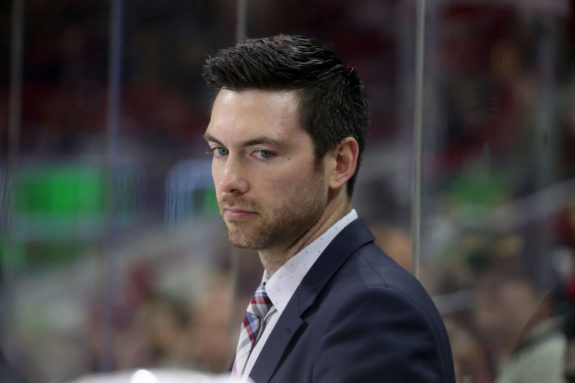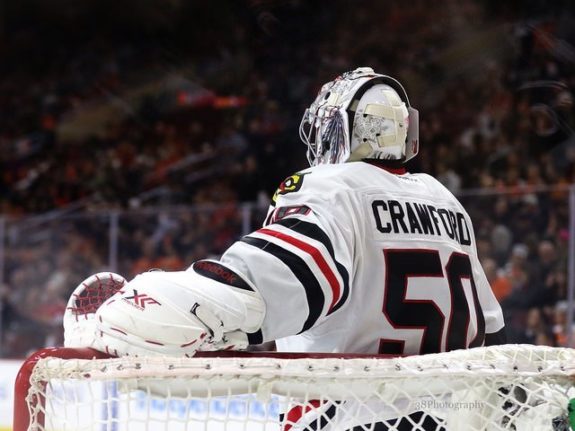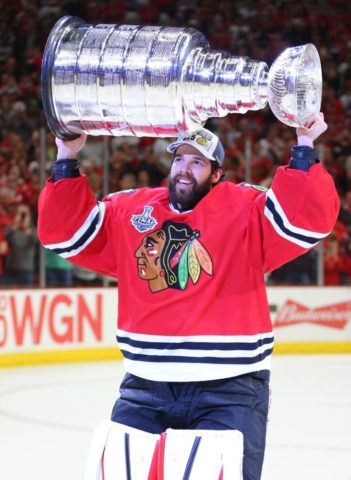![]()
Chicago Blackhawks goaltender Corey Crawford has been one of the most important players in the franchise’s golden age of hockey. He was between the pipes for two Stanley Cup championships, and many realized just how valuable he was when he missed most of last season. While the past has been great, it could be time to move on in order to improve the future.
Semantics Can Make a Huge Difference
Back on Nov. 6, the Blackhawks made a franchise-altering coaching change when they fired three-time Stanley Cup winner Joel Quenneville and replaced him with 33-year-old Jeremy Colliton. While the play on the ice the last year was a pretty good sign that the championship window has closed, the firing of Quenneville slammed it down and nailed it shut.
Fans will debate for years to come if the coaching change was a mistake, but the biggest error to happen on that day was the use of a single word. Team president John McDonough refused to call this a rebuild and assured the fan base that this was still a playoff team.
“I wouldn’t label it as a rebuilding, I would reference it more as a remodeling,” McDonough said in an official statement. “You still have Hall of Fame players; my expectations are that this is a playoff team. And if you get in, anything can happen. So that is the phase that we are in right now. You never know whether to call it a rebuild or a remodel. We want to win. We want to rewin. … Sometimes, as painful as it is, you need a fresh start.”

Since the move, the Blackhawks have gone 3-12-2 with just two regulation wins. That is hardly the work of a playoff team. The fans are tough. They can handle the word rebuild. As the Blackhawks sit with fewest points in the NHL, it is time to make even bigger moves than firing Quenneville.
Related: Blackhawks’ Losing Script Continues
Crawford Has Not Been the Savior
Many felt that the biggest reason the Blackhawks missed the playoffs last year was due to the absence of Crawford for the second half of the season. Now that Crawford has returned, that theory might not be entirely true. His numbers have taken a major dip from what we have been used to seeing from number 50. In his 28 games played last year, Crawford posted a .929 save percentage (SV%) and a 2.27 goals-against average (GAA) while facing 30 shots a game. He has a .901 SV% and 3.21 GAA while facing 31.4 shots per game in his 20 appearances this season.
Obviously, if you have watched any of his starts, the dramatic drop is not entirely his fault. The team in front of him has been an absolute dumpster fire that usually doesn’t start playing defense until late in the first period if at all. Crawford certainly has let in his fair share of soft goals over the past few games, but overall, he has little to do with the mess on the ice.

With the team going nowhere this year and likely to be bad again next season, Crawford is more valuable to the team as a trade chip than as its starting goaltender. If the front office realizes that it is time to tear things down and start over, getting some of their veterans to waive their no-movement clauses will be a key part of a rebuild.
Moving on from some of the biggest names from the franchise’s most successful era will be a hard pill to swallow for fans, but nothing lasts forever. It is hard to see them trading Jonathan Toews or Patrick Kane, even though they’d bring in the biggest returns. Nobody wants Brent Seabrook’s albatross of a contract, and Stan Bowman has already traded enough young players to get rid of bad paper.
The two players that would make sense to trade before the deadline is Crawford and Duncan Keith. As the record continues to head in the wrong direction, getting them to accept a deal to a contender may become easier. In the case of Crawford, his no-trade clause is modified which means he can submit a list of 10 teams he would accept a trade to.
Is There a Market for Crawford?
Crawford has been one of the best goaltenders in Blackhawks history. They only two netminders with more games played and wins are Hall-of-Famers Glenn Hall and Tony Esposito. Crawford has his name on two Stanley Cups and could have easily won the Conn Smythe Trophy in both 2013 and 2015. With the Blackhawks talented young crop of defensemen still likely two years away from making an impact, it is time to start building the talent up front.

When Crawford first signed his six-year, $36-million contract in 2014, many criticized the amount of money he was paid. Fast-forward to late 2018 and $6 million a year for a top starting goaltender seems like a pretty good deal. He is the eighth-highest paid goaltender in the league with guys like Jimmy Howard, Roberto Luongo and Mike Smith having cap hits less than $1 million less than his. The biggest issue in trading Crawford could be that he has another year left on his deal. The majority of the players who get moved in-season are usually on expiring contracts.
Another problem is that there does not appear to be many teams in the market for a goaltender. The Carolina Hurricanes, who the Blackhawks have a good trading relationship with, could use a guy like Crawford in goal if they want to make a run at the postseason. The Philadelphia Flyers always seem to need a quality net minder and new general manager Chuck Fletcher could be looking to make a big splash. Former Blackhawk Antti Raanta is likely out for the rest of the season, so another deal with the Arizona Coyotes could be possible.
While there doesn’t seem to be much of a trade in mid-December, there is a long way to go until the Feb. 25 trade deadline. Injuries will happen and teams who didn’t expect to contend will be fighting for a playoff spot so the landscape will be much different 10 weeks.
What Kind of Return Would Crawford Fetch?
If we do get to the point where actual trade discussions involving Crawford happen it will be very interesting to see what the Blackhawks can get for him. Usually, at the trade deadline, teams will look for veteran backups for the stretch run instead of a starter for the postseason.
The biggest goaltender trade we saw in the offseason was Philipp Grubauer being sent from the Washington Capitals to the Colorado Avalanche for a second-round draft pick. You’d like to think that Crawford would be worth more than that since he is a much more accomplished player than Grubauer.

When you look at other recent trade for starting net minders the returns are a mixed bag. The Coyotes got Chad Johnson, Brandon Hickey and a third-round pick for Smith in 2017. The Dallas Stars gave up just a fourth-round pick for the rights to Ben Bishop that same summer. The St. Louis Blues gave up Jaroslav Halak, Chris Stewart, William Carrier, a first and third-round pick for Ryan Miller and Steve Ott at the 2014 trade deadline. At that same deadline, the Vancouver Canucks got Jacob Markstrom and Shawn Mattias for Luongo.
Obviously, teams tend to be more desperate at the trade deadline than in the offseason. If you can catch a team like the 2014 Blues that are willing to overpay, then the return will be much better. A trade of Crawford would not give you all the pieces for a successful rebuild, but it would be a good start.
The brass can use whatever word they want to describe the season. Whether it is a remodel or a fresh start this is a bad hockey team that is going nowhere fast. There are pieces to help improve things down the road like Adam Boqvist, Nicolas Beaudin and Ian Mitchell. It is nice to dream of adding Jack Hughes to a group that includes Toews, Kane, Alex DeBrincat, Brandon Saad and Dylan Strome. But you still need more. A trade of Corey Crawford starts filling in the holes.